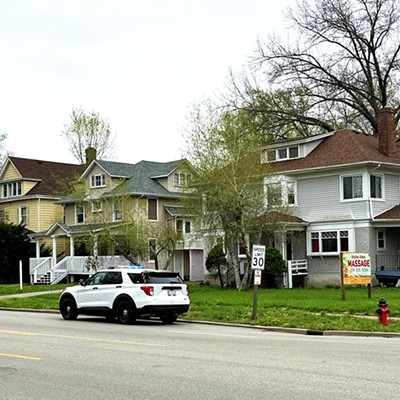A dog's life
Pit bulls and shepherds and chows — oh my! Being vicious isn’t easy, and I should know.

[
{
"name": "Air - MedRect Combo - Inline Content 1",
"component": "11490391",
"insertPoint": "3",
"requiredCountToDisplay": "1",
"parentWrapperClass": "fdn-ads-inline-content-block"
},{
"name": "Air - MedRect Combo - Inline Content 2",
"component": "11490392",
"insertPoint": "7",
"requiredCountToDisplay": "5",
"parentWrapperClass": "fdn-ads-inline-content-block"
},{
"name": "Air - MedRect Combo - Inline Content 3",
"component": "11490393",
"insertPoint": "12",
"requiredCountToDisplay": "9",
"parentWrapperClass": "fdn-ads-inline-content-block"
}
]
People are stupid, or maybe just weird. So far as
I’m concerned, that’s a good thing.
I’ve been a naughty dog — check out my
file at Sangamon County Animal Control. In October 2004, officials at St.
Francis Cabrini
School called animal control because I was wandering through the school
parking lot. They described me as friendly at the pound, but I do have a
mean streak. In May, I got loose again and attacked a poodle.
My owner, George T. Young III, denied that it was me,
but I had blood on my neck when animal control arrived, and a witness made
a positive ID. Even so, animal control issued no citations. Instead, the
doggie police sent my owner a letter asking him to be aware of my
whereabouts, but it didn’t do much good. A month later, I again got
loose from my owner’s house, at 3056 Louise Lane. Once again, animal
control told my owner to be more careful.
Even I could see that letters and fines and cajoling
wouldn’t work.
For at least three years, my owner has kept dogs that
get loose and bite. In 2002, a pit-bull mix got out and attacked a beagle
named Lucy, who was in her owner’s yard and minding her own business.
Lucy ended up with stitches and a drainage tube in her chest. My owner was
cited for not restraining his dog. In 2003 alone, animal-control records
show, at least four dogs in the neighborhood were attacked by dogs that
lived at my owner’s house. In one of the cases, a retriever had its
snout ripped open when a pit bull kept by my owner tried to drag it through
a closed gate. As in the other cases, the pit bull had gotten loose. After
biting yet another dog a couple months later, my owner allowed animal
control to send his pit bull Sadie to doggie heaven. Animal control
didn’t report any problems at my address for more than a year
afterward.
Then I came along.
Last fall, I scored a human being.
In September, Eugene Gallant, who lives a few doors down, was walking Pogo, his mixed-breed dog, at St. Francis Cabrini School. Pogo was on a leash when I came charging. Before slipping his collar and running home with me in hot pursuit, Pogo, terrified, tried leaping into Gallant’s arms. I lunged but missed. Instead of Pogo, I sank my teeth into Gallant’s left hand. Pogo’s fine, and so am I. But Gallant got 18 stitches, then spent two days in a hospital fighting an infection. Gallant doesn’t think I meant to hurt him, and who am I to argue? But he’s sued my owner, asking for more than $50,000. If I could talk, I’d say “ka-ching”— besides pain, suffering and medical bills, James Rammelkamp, Gallant’s lawyer, says that he’s going for punitive damages because my owner has a history of letting his dogs run loose. My owner’s lawyer is blaming Gallant — if he hadn’t gotten in the way of fighting dogs, he wouldn’t have gotten hurt. But Rammelkamp seems like a serious attorney. “That’s a stretch,” he says with a straight face. My owner, bless his soul, says it’s a case of mistaken identity: He insists that I’ve never bitten a person or another dog. He blames Sadie for earning him — and me — a rep we just can’t shake. “I had one bad dog — I admit it,” he says. “Every time something would happen that had to do with a dog, whether it was red, purple or green, animal control was at my door. The [animal control] records is wrong.” Yes, Sadie was a veritable Houdini when it came to escaping her pen, but I’m different, my owner says. I’m an inside dog. Sure, the doggie police arrested me for wandering the school parking lot, but folks at Cabrini fell instantly in love and took me from classroom to classroom for show-and-tell, my owner claims. Dogs can’t laugh, so I won’t. Let’s just say that the idea of teachers’ showing off a stray pit bull to preschoolers doesn’t make much sense. Dogs that seriously injure people in Illinois can be declared vicious, but that hasn’t happened to me — after all, Lucky isn’t just my middle name, it’s my only name. After the attack on Gallant, animal control officials ruled that I was merely dangerous. That means I’m supposed to be neutered and microchipped. I also have to wear a leash and a muzzle and be under an adult’s supervision when I leave the house. My owner has refused to neuter me. “Why don’t you cut your own balls off?” he suggested when an animal-control officer offered to refund fines and boarding fees if I got fixed. The punishment is light and far from certain if my owner breaks the rules. Under the state’s dangerous-dog law, it’s a misdemeanor if I get loose again and seriously injure a person or another animal, and that’s only if the state can prove that my owner knowingly didn’t follow all of the rules. If he can convince a judge or jury that I got loose by accident, he’s off the hook. Only if someone dies will he be guilty of a felony, and then only if the state can show that it wasn’t an accident. I’m one strike into a three-strikes deal. I can’t be declared vicious unless I’m found dangerous twice more — or unless someone gets seriously hurt. Even then, I won’t go to the big doghouse in the sky. But it won’t be much of a life. A dog that’s been declared vicious must live inside a pen or other enclosure with 6-foot-high walls. If it’s a room, the room must be locked, and you can’t leave for any reason other than to receive veterinary care. No going for walks, no fetching balls, no sniffing hydrants or playing with other dogs. Sheri Carey, an assistant state’s attorney who knows all about me, says that the county didn’t go for the “vicious” label in my case because there would have been problems proving that it was really me. OK, my brain is one-twentieth the size of a lawyer’s, but I think they had a pretty good case. There were other witnesses besides Gallant, who got a good look and made a positive ID. One neighbor who went outside to see what all the barking was about recognized me, saw me bite Gallant, and watched me bolt after Pogo. After rushing to help Gallant, the neighbor saw me running loose in the street and looked on as my owner retrieved me and took me home. My owner didn’t appeal the “dangerous” designation or contest the ticket.
I’ve been keeping a low profile ever since — Gallant wonders whether I’m staying elsewhere. He’s right. My owner says that he’s given me to his brother, but he won’t reveal my new address. Animal control can’t be sure of where any dangerous dog is living. “There’s no tracking for any of them,” says Greg Largent, director of operations for the Sangamon County Animal Control Center. Animal control has my microchip number, but I’m the exception. County officials don’t know the chip numbers of the other nine dogs declared dangerous since the Legislature passed a law in 2003 that was supposed to get tough on biters and their owners. Although animal control can order a dog owner to install a microchip, nothing compels an owner to disclose the chip number so that a dog can be easily identified if it bites again — or so says Largent, who’s the county’s chief enforcer. “The law has got some serious problems,” he says. “Unless it was microchipped here, I don’t have the chip number, in most cases.” But Carey, the prosecutor, says that lawmakers closed the loophole last year so that the county gets chip numbers. Ledy VanKavage, a lobbyist for the American Society for the Prevention of Cruelty to Animals, says the same thing. Sheesh — the front paw doesn’t seem to know what the hind paw’s doing around here.
I’m not the only dog in Sangamon County doing fine after biting and scaring the bejeebers out of people. Sampson, a German shepherd who lives in the 6600 block of West Iles Avenue, was declared dangerous — but not vicious — in June 2004 after he bit a jogger in the leg. The wound required stitches. Letter carriers in the neighborhood weren’t surprised. Two years before the jogger was injured, a postal carrier told animal control that Sampson was so mean that he wouldn’t get out of his Jeep within a half-mile if the dog was loose. Another carrier told investigators that Sampson had attacked his vehicle and left bite marks on the fenders. Close calls aren’t enough — someone has to be badly hurt before dogs such as Sampson and I get in serious trouble. “The law says the dog has to inflict serious physical injury — if you just had a few stitches, the dog’s not going to be declared a vicious dog,” explains Largent, whose agency responds to at least one bite case a day. “The dog has to damn near kill a person to get it declared vicious today.” If I lived someplace else, I might be dead. In the state of Washington, for example, the owner of a dog that bites must either post a $250,000 bond or obtain that much liability-insurance coverage if the injury requires more than one stitch. It’s a de facto ban on biting dogs because few, if any, insurance companies will take the risk, say the people who pressed for the law. It doesn’t kick in if someone was trespassing or provoking the dog. “It’s common sense, without the emotion,” says Glen Bui, vice president of the American Canine Foundation — and he owns six dogs, including a wolf hybrid, a pit bull, and a poodle. Where I live, folks can keep dogs that have disfigured people, with no insurance at all, regardless of whether their dogs have been declared dangerous or vicious. I think animals are more important than people, and who can blame me? No law mandates that a dog be euthanized if it maims or kills a person. However, a farmer who catches a dog attacking a chicken may legally kill a dog on the spot, no questions asked, even if the chicken lives. Forget my owner: VanKavage, who owns pit bulls herself, is my best friend. No way, says the ASPCA lobbyist, should the owner of a dog declared dangerous or vicious be required to get liability insurance. That just isn’t workable, she says, citing the exact same reason Bui says it is workable: Insurance companies, VanKavage says, won’t insure such a dog, which means euthanasia. There are already plenty of laws to take care of dogs that bite, VanKavage says. The problem, she says, is that animal-control officers don’t use them. To VanKavage, every dog’s life is precious — she also says that life without parole in a pen for a vicious dog is better than being put down. I don’t know about that, but I’m right with her when she says that it’s the owner’s fault, not the dog’s, when someone gets bitten.
When the Legislature changed dog-control laws in 2003, lawmakers said that they were getting tough, but I can’t see how. Three of the seven dogs declared vicious in Sangamon County in the 17 months before the law changed were euthanized. The other four vicious dogs must live in enclosures approved by animal control, which didn’t declare any dogs dangerous before the law changed. Just two of 15 dogs declared vicious or dangerous since the law changed have been put down. Those two were euthanized after their third dangerous strikes in less than seven months, so they faced life sentences in a pen. Animal control doesn’t have the power to approve enclosures for the dozen surviving dangerous dogs, me included. As a dog, I have rights — or, at least, my owner does. Lawmakers three years ago changed the standard of proof in vicious-dog cases from preponderance of evidence to clear and convincing evidence. The difference can be huge. “Preponderance” meant that the doggie cops needed to show it was more likely than not that a dog needed confinement — if 51 percent of the evidence is against a dog, it loses. “‘Clear and convincing’ is 70 percent,” Carey says. The folks who pick up the carcasses and impound the biters and sometimes wield the euthanizing needle say that they don’t have enough discretion or power. Largent and other animal-control officers are asking lawmakers to restore their authority to declare a dog vicious and order it confined. They say that it’s too difficult to get a dog declared vicious in Illinois. “If you look at the Animal Control Act, there’s an almost infinite number of excuses that could be conjured up by an owner to prevent a dog from being declared vicious,” Largent says. For example, the law says that a dog can’t be declared vicious if the person who was bitten had at some time in the past abused, assaulted, or physically threatened the animal or its offspring. “So, the dog remembers that you walked up to it and smacked it across the mouth six months ago — if it decides to maul you, it’s justified,” Largent says. “There’s so many excuses as to why a dog did what it did. It’s hard to get into the mind of a dog and ask it what it was thinking at the time it committed its offense. “A dog should be held accountable for its actions.”
Leash laws, schmeash laws. I’m on the lam today to check out the Legislature, where no fewer than a half-dozen bills have been introduced to keep people safe from dogs like me. Many people are afraid of pit bulls, but I feel pretty safe here. After all, I look just like a lobbyist. My ancestors and I have been man’s best friend for at least 10,000 years, and politicians have probably been around even longer than that, but lawmakers still can’t figure out how to deal with us. Rep. Mike Boland, D-East Moline, who is sponsoring a bill that would make felons of dog owners whose intact pets seriously hurt someone, compares dog legislation to laws about guns. “It’s a tough issue for government,” he says. “People are very suspicious of government doing anything. They look at it as a personal property issue.”
Proposals run the gamut. Some lawmakers want to give local governments the power to ban pit bulls and other breeds with a reputation for being dangerous. One bill would prohibit felons from owning dogs that aren’t spayed or neutered, on the theory that intact dogs are the most aggressive and can be used as weapons. Another bill would allow $5,000 fines for owners of dogs declared vicious, and still others would allow local governments to ban pit bulls or other breeds with reputations for being dangerous. Feeding the frenzy are some attacks last year that make me look like Fluffy the Declawed Kitty. Boland’s bill was prompted by the fatal mauling of a 14-year-old girl who was attacked by three pit bulls and a mixed-breed a year ago. In November, police in a Chicago suburb shot and killed three pit bulls that mauled a pair of 10-year-olds who were selling Girl Scout products. One of the children ended up in critical condition. The dogs also bit four adults, including their owner, who nearly lost a thumb. The dogs charged through an open door as the children were walking past the house. What’s baffling is how much dog lovers disagree on what’s best for me and my human friends. For instance, animal-control officers want the power to declare dogs vicious without going to a judge, a notion opposed by the ASPCA. Boland and VanKavage, who appeared at a Jan. 24 press conference and boasted that Boland’s bill had the support of the Illinois State Police and the Illinois Association of Chiefs of Police, were blindsided a couple of hours later, when a lobbyist for the Illinois State Veterinary Association said that veterinarians opposed it. Boland and VanKavage had just told the agriculture committee that because most serious dog attacks are committed by intact animals, it makes sense to make criminals of owners of unfixed animals that hurt people. It’s not that simple, responded Terry Stezco, lobbyist for the veterinarians. “Just to address that one factor is not enough,” Stezco told lawmakers. “The fact that a dog is intact has no relationship to irresponsible or responsible ownership.” Lawmakers need to adopt a more “comprehensive” law, Stezco said. Then a committee member suggested making criminals of the owners of biting dogs even if the animal in question is fixed. That would have been one of the toughest dog laws in the nation, and it wasn’t likely to go anywhere, especially in a committee dominated by farming interests. With things quickly spinning out of control, the committee tabled the bill. Afterward, Stezco refused to say just what “comprehensive” means or which of the half-dozen pending dog bills veterinarians favor. “I’m not at liberty right now to go into specifics,” Stezco said when I asked him what vets would like to see. “We’re trying to develop our position.” Talk about dogs playing poker. Perhaps the strangest political bedfellows are Jeff Armstrong, founder of Parents Against Irresponsible Dog Owners, and the American Canine Foundation, for which he is a consultant. Armstrong is a big deal in doggie politics; VanKavage has his number at her fingertips, and Largent has set up a meeting with him to push for getting courts out of the vicious-dog-designation business. In 2001, Armstrong’s son Ryan, then 8, was attacked by a rottweiler near Chicago. The dog, which partially severed the boy’s thumb in the attack, had been involved in two previous attacks, but its owner was fined just $200. The bill lawmakers passed in 2003 is known as Ryan’s Law, and Armstrong now says that it wasn’t enough. Among other things, Ryan’s Law allows criminal prosecution of the owners of dangerous or vicious dogs that strike again, but there’s not much anyone can do the first time someone gets hurt. After his son was nearly killed, Armstrong says, his first reaction was to ban pit bulls and other breeds with bad reps. “In the beginning, I wanted them all off the earth,” he says. Five years later, you’d think that he had a kennel full of dogs that look like me. Banning breeds, Armstrong says, does no good. For one thing, it’s impossible to define just what a pit bull is. For another, courts in some parts of the country have overturned breed bans on constitutional grounds. “If it ain’t going to work, why am I wasting my time?” he asks. Armstrong is now in lockstep with Bui, the American Canine Foundation vice president and dog lover who favors tough leash laws — $250 for a first offense isn’t out of bounds, Bui says — and mandatory liability insurance for owners whose dogs are declared dangerous or vicious. “Glen and I are pretty much on the same page,” Armstrong says. “I think people have to be held accountable. You’ve got to hit them hard and hit them hard fast and hit them in the pocketbook. That’s the only thing we can do.” Woof.
In September, Eugene Gallant, who lives a few doors down, was walking Pogo, his mixed-breed dog, at St. Francis Cabrini School. Pogo was on a leash when I came charging. Before slipping his collar and running home with me in hot pursuit, Pogo, terrified, tried leaping into Gallant’s arms. I lunged but missed. Instead of Pogo, I sank my teeth into Gallant’s left hand. Pogo’s fine, and so am I. But Gallant got 18 stitches, then spent two days in a hospital fighting an infection. Gallant doesn’t think I meant to hurt him, and who am I to argue? But he’s sued my owner, asking for more than $50,000. If I could talk, I’d say “ka-ching”— besides pain, suffering and medical bills, James Rammelkamp, Gallant’s lawyer, says that he’s going for punitive damages because my owner has a history of letting his dogs run loose. My owner’s lawyer is blaming Gallant — if he hadn’t gotten in the way of fighting dogs, he wouldn’t have gotten hurt. But Rammelkamp seems like a serious attorney. “That’s a stretch,” he says with a straight face. My owner, bless his soul, says it’s a case of mistaken identity: He insists that I’ve never bitten a person or another dog. He blames Sadie for earning him — and me — a rep we just can’t shake. “I had one bad dog — I admit it,” he says. “Every time something would happen that had to do with a dog, whether it was red, purple or green, animal control was at my door. The [animal control] records is wrong.” Yes, Sadie was a veritable Houdini when it came to escaping her pen, but I’m different, my owner says. I’m an inside dog. Sure, the doggie police arrested me for wandering the school parking lot, but folks at Cabrini fell instantly in love and took me from classroom to classroom for show-and-tell, my owner claims. Dogs can’t laugh, so I won’t. Let’s just say that the idea of teachers’ showing off a stray pit bull to preschoolers doesn’t make much sense. Dogs that seriously injure people in Illinois can be declared vicious, but that hasn’t happened to me — after all, Lucky isn’t just my middle name, it’s my only name. After the attack on Gallant, animal control officials ruled that I was merely dangerous. That means I’m supposed to be neutered and microchipped. I also have to wear a leash and a muzzle and be under an adult’s supervision when I leave the house. My owner has refused to neuter me. “Why don’t you cut your own balls off?” he suggested when an animal-control officer offered to refund fines and boarding fees if I got fixed. The punishment is light and far from certain if my owner breaks the rules. Under the state’s dangerous-dog law, it’s a misdemeanor if I get loose again and seriously injure a person or another animal, and that’s only if the state can prove that my owner knowingly didn’t follow all of the rules. If he can convince a judge or jury that I got loose by accident, he’s off the hook. Only if someone dies will he be guilty of a felony, and then only if the state can show that it wasn’t an accident. I’m one strike into a three-strikes deal. I can’t be declared vicious unless I’m found dangerous twice more — or unless someone gets seriously hurt. Even then, I won’t go to the big doghouse in the sky. But it won’t be much of a life. A dog that’s been declared vicious must live inside a pen or other enclosure with 6-foot-high walls. If it’s a room, the room must be locked, and you can’t leave for any reason other than to receive veterinary care. No going for walks, no fetching balls, no sniffing hydrants or playing with other dogs. Sheri Carey, an assistant state’s attorney who knows all about me, says that the county didn’t go for the “vicious” label in my case because there would have been problems proving that it was really me. OK, my brain is one-twentieth the size of a lawyer’s, but I think they had a pretty good case. There were other witnesses besides Gallant, who got a good look and made a positive ID. One neighbor who went outside to see what all the barking was about recognized me, saw me bite Gallant, and watched me bolt after Pogo. After rushing to help Gallant, the neighbor saw me running loose in the street and looked on as my owner retrieved me and took me home. My owner didn’t appeal the “dangerous” designation or contest the ticket.
I’ve been keeping a low profile ever since — Gallant wonders whether I’m staying elsewhere. He’s right. My owner says that he’s given me to his brother, but he won’t reveal my new address. Animal control can’t be sure of where any dangerous dog is living. “There’s no tracking for any of them,” says Greg Largent, director of operations for the Sangamon County Animal Control Center. Animal control has my microchip number, but I’m the exception. County officials don’t know the chip numbers of the other nine dogs declared dangerous since the Legislature passed a law in 2003 that was supposed to get tough on biters and their owners. Although animal control can order a dog owner to install a microchip, nothing compels an owner to disclose the chip number so that a dog can be easily identified if it bites again — or so says Largent, who’s the county’s chief enforcer. “The law has got some serious problems,” he says. “Unless it was microchipped here, I don’t have the chip number, in most cases.” But Carey, the prosecutor, says that lawmakers closed the loophole last year so that the county gets chip numbers. Ledy VanKavage, a lobbyist for the American Society for the Prevention of Cruelty to Animals, says the same thing. Sheesh — the front paw doesn’t seem to know what the hind paw’s doing around here.
I’m not the only dog in Sangamon County doing fine after biting and scaring the bejeebers out of people. Sampson, a German shepherd who lives in the 6600 block of West Iles Avenue, was declared dangerous — but not vicious — in June 2004 after he bit a jogger in the leg. The wound required stitches. Letter carriers in the neighborhood weren’t surprised. Two years before the jogger was injured, a postal carrier told animal control that Sampson was so mean that he wouldn’t get out of his Jeep within a half-mile if the dog was loose. Another carrier told investigators that Sampson had attacked his vehicle and left bite marks on the fenders. Close calls aren’t enough — someone has to be badly hurt before dogs such as Sampson and I get in serious trouble. “The law says the dog has to inflict serious physical injury — if you just had a few stitches, the dog’s not going to be declared a vicious dog,” explains Largent, whose agency responds to at least one bite case a day. “The dog has to damn near kill a person to get it declared vicious today.” If I lived someplace else, I might be dead. In the state of Washington, for example, the owner of a dog that bites must either post a $250,000 bond or obtain that much liability-insurance coverage if the injury requires more than one stitch. It’s a de facto ban on biting dogs because few, if any, insurance companies will take the risk, say the people who pressed for the law. It doesn’t kick in if someone was trespassing or provoking the dog. “It’s common sense, without the emotion,” says Glen Bui, vice president of the American Canine Foundation — and he owns six dogs, including a wolf hybrid, a pit bull, and a poodle. Where I live, folks can keep dogs that have disfigured people, with no insurance at all, regardless of whether their dogs have been declared dangerous or vicious. I think animals are more important than people, and who can blame me? No law mandates that a dog be euthanized if it maims or kills a person. However, a farmer who catches a dog attacking a chicken may legally kill a dog on the spot, no questions asked, even if the chicken lives. Forget my owner: VanKavage, who owns pit bulls herself, is my best friend. No way, says the ASPCA lobbyist, should the owner of a dog declared dangerous or vicious be required to get liability insurance. That just isn’t workable, she says, citing the exact same reason Bui says it is workable: Insurance companies, VanKavage says, won’t insure such a dog, which means euthanasia. There are already plenty of laws to take care of dogs that bite, VanKavage says. The problem, she says, is that animal-control officers don’t use them. To VanKavage, every dog’s life is precious — she also says that life without parole in a pen for a vicious dog is better than being put down. I don’t know about that, but I’m right with her when she says that it’s the owner’s fault, not the dog’s, when someone gets bitten.
When the Legislature changed dog-control laws in 2003, lawmakers said that they were getting tough, but I can’t see how. Three of the seven dogs declared vicious in Sangamon County in the 17 months before the law changed were euthanized. The other four vicious dogs must live in enclosures approved by animal control, which didn’t declare any dogs dangerous before the law changed. Just two of 15 dogs declared vicious or dangerous since the law changed have been put down. Those two were euthanized after their third dangerous strikes in less than seven months, so they faced life sentences in a pen. Animal control doesn’t have the power to approve enclosures for the dozen surviving dangerous dogs, me included. As a dog, I have rights — or, at least, my owner does. Lawmakers three years ago changed the standard of proof in vicious-dog cases from preponderance of evidence to clear and convincing evidence. The difference can be huge. “Preponderance” meant that the doggie cops needed to show it was more likely than not that a dog needed confinement — if 51 percent of the evidence is against a dog, it loses. “‘Clear and convincing’ is 70 percent,” Carey says. The folks who pick up the carcasses and impound the biters and sometimes wield the euthanizing needle say that they don’t have enough discretion or power. Largent and other animal-control officers are asking lawmakers to restore their authority to declare a dog vicious and order it confined. They say that it’s too difficult to get a dog declared vicious in Illinois. “If you look at the Animal Control Act, there’s an almost infinite number of excuses that could be conjured up by an owner to prevent a dog from being declared vicious,” Largent says. For example, the law says that a dog can’t be declared vicious if the person who was bitten had at some time in the past abused, assaulted, or physically threatened the animal or its offspring. “So, the dog remembers that you walked up to it and smacked it across the mouth six months ago — if it decides to maul you, it’s justified,” Largent says. “There’s so many excuses as to why a dog did what it did. It’s hard to get into the mind of a dog and ask it what it was thinking at the time it committed its offense. “A dog should be held accountable for its actions.”
Leash laws, schmeash laws. I’m on the lam today to check out the Legislature, where no fewer than a half-dozen bills have been introduced to keep people safe from dogs like me. Many people are afraid of pit bulls, but I feel pretty safe here. After all, I look just like a lobbyist. My ancestors and I have been man’s best friend for at least 10,000 years, and politicians have probably been around even longer than that, but lawmakers still can’t figure out how to deal with us. Rep. Mike Boland, D-East Moline, who is sponsoring a bill that would make felons of dog owners whose intact pets seriously hurt someone, compares dog legislation to laws about guns. “It’s a tough issue for government,” he says. “People are very suspicious of government doing anything. They look at it as a personal property issue.”
Proposals run the gamut. Some lawmakers want to give local governments the power to ban pit bulls and other breeds with a reputation for being dangerous. One bill would prohibit felons from owning dogs that aren’t spayed or neutered, on the theory that intact dogs are the most aggressive and can be used as weapons. Another bill would allow $5,000 fines for owners of dogs declared vicious, and still others would allow local governments to ban pit bulls or other breeds with reputations for being dangerous. Feeding the frenzy are some attacks last year that make me look like Fluffy the Declawed Kitty. Boland’s bill was prompted by the fatal mauling of a 14-year-old girl who was attacked by three pit bulls and a mixed-breed a year ago. In November, police in a Chicago suburb shot and killed three pit bulls that mauled a pair of 10-year-olds who were selling Girl Scout products. One of the children ended up in critical condition. The dogs also bit four adults, including their owner, who nearly lost a thumb. The dogs charged through an open door as the children were walking past the house. What’s baffling is how much dog lovers disagree on what’s best for me and my human friends. For instance, animal-control officers want the power to declare dogs vicious without going to a judge, a notion opposed by the ASPCA. Boland and VanKavage, who appeared at a Jan. 24 press conference and boasted that Boland’s bill had the support of the Illinois State Police and the Illinois Association of Chiefs of Police, were blindsided a couple of hours later, when a lobbyist for the Illinois State Veterinary Association said that veterinarians opposed it. Boland and VanKavage had just told the agriculture committee that because most serious dog attacks are committed by intact animals, it makes sense to make criminals of owners of unfixed animals that hurt people. It’s not that simple, responded Terry Stezco, lobbyist for the veterinarians. “Just to address that one factor is not enough,” Stezco told lawmakers. “The fact that a dog is intact has no relationship to irresponsible or responsible ownership.” Lawmakers need to adopt a more “comprehensive” law, Stezco said. Then a committee member suggested making criminals of the owners of biting dogs even if the animal in question is fixed. That would have been one of the toughest dog laws in the nation, and it wasn’t likely to go anywhere, especially in a committee dominated by farming interests. With things quickly spinning out of control, the committee tabled the bill. Afterward, Stezco refused to say just what “comprehensive” means or which of the half-dozen pending dog bills veterinarians favor. “I’m not at liberty right now to go into specifics,” Stezco said when I asked him what vets would like to see. “We’re trying to develop our position.” Talk about dogs playing poker. Perhaps the strangest political bedfellows are Jeff Armstrong, founder of Parents Against Irresponsible Dog Owners, and the American Canine Foundation, for which he is a consultant. Armstrong is a big deal in doggie politics; VanKavage has his number at her fingertips, and Largent has set up a meeting with him to push for getting courts out of the vicious-dog-designation business. In 2001, Armstrong’s son Ryan, then 8, was attacked by a rottweiler near Chicago. The dog, which partially severed the boy’s thumb in the attack, had been involved in two previous attacks, but its owner was fined just $200. The bill lawmakers passed in 2003 is known as Ryan’s Law, and Armstrong now says that it wasn’t enough. Among other things, Ryan’s Law allows criminal prosecution of the owners of dangerous or vicious dogs that strike again, but there’s not much anyone can do the first time someone gets hurt. After his son was nearly killed, Armstrong says, his first reaction was to ban pit bulls and other breeds with bad reps. “In the beginning, I wanted them all off the earth,” he says. Five years later, you’d think that he had a kennel full of dogs that look like me. Banning breeds, Armstrong says, does no good. For one thing, it’s impossible to define just what a pit bull is. For another, courts in some parts of the country have overturned breed bans on constitutional grounds. “If it ain’t going to work, why am I wasting my time?” he asks. Armstrong is now in lockstep with Bui, the American Canine Foundation vice president and dog lover who favors tough leash laws — $250 for a first offense isn’t out of bounds, Bui says — and mandatory liability insurance for owners whose dogs are declared dangerous or vicious. “Glen and I are pretty much on the same page,” Armstrong says. “I think people have to be held accountable. You’ve got to hit them hard and hit them hard fast and hit them in the pocketbook. That’s the only thing we can do.” Woof.
Illinois Times has provided readers with independent journalism for almost 50 years, from news and politics to arts and culture.
Your support will help cover the costs of editorial content published each week. Without local news organizations, we would be less informed about the issues that affect our community..
Got something to say?
Send a letter to the editor and we'll publish your feedback in print!























